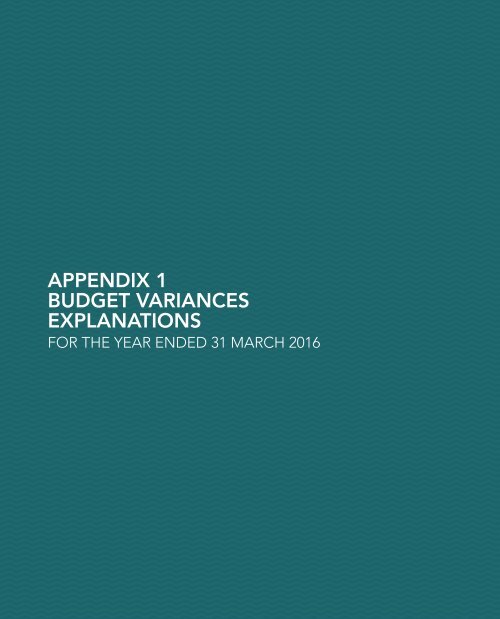SAMSA Annual Report 2015 - 2016
Create successful ePaper yourself
Turn your PDF publications into a flip-book with our unique Google optimized e-Paper software.
Budget Variances Explanations<br />
ANNUAL FINANCIAL STATEMENTS<br />
CHAPTER 06<br />
APPENDIX 1<br />
BUDGET VARIANCES<br />
EXPLANATIONS FOR THE PERIOD ENDED 31 MARCH <strong>2016</strong><br />
1. INTRODUCTION<br />
It has been another very difficult financial year for the Authority as its tariff structure still remained unadjusted against increasing costs<br />
of running the organisation. Since 2009, the tariffs have only been adjusted by CPI only once and it became very difficult to<br />
adequately deliver on the mandate of the organisation under the circumstances. For the organisation to be sustainable and deliver<br />
on it mandates, tariff adjustments and development of the new funding models are very critical.<br />
The organisation strived to do its best under the circumstances to continue to deliver on its mandates. The financial year ending 31<br />
March <strong>2016</strong> has seen the reduction of the deficit to R29 million (2014/15: 81 million). This reduction was achieved by further cost<br />
cutting measures to ensure that the organisation continued to operate without a complete breakdown of service delivery capabilities.<br />
The major variances in revenue and expenses are analysed in full detail below.<br />
APPENDIX 1<br />
BUDGET VARIANCES<br />
EXPLANATIONS<br />
FOR THE YEAR ENDED 31 MARCH <strong>2016</strong><br />
2. REVENUE<br />
The organisation collected more revenue by R6.4 million during the financial year which was due to the contributions received from<br />
the Maritime Fund for the settlement of the debt owing to Smit Amandla. Revenue was also boosted by the increase in management<br />
fees which were earned from the contract with the Department of Agriculture and Fisheries for the management of their ships. The<br />
<strong>SAMSA</strong> core revenues remained at the same levels due to continued non-adjustment of tariffs. In this regard, <strong>SAMSA</strong> Levies, which<br />
contributes the highest portion of revenue earned remained pegged at R250 million.<br />
3. EXPENDITURES<br />
During the course of the financial year, the primary focus remained on the management of increasing costs against stagnant revenue.<br />
More strict measures had to be taken towards the end of the financial year as it became clear that a tariff adjustment was not going<br />
to be approved and implemented during the financial year. Despite these extraordinary measures, the organisation continued to<br />
struggle with the settlement of creditors which is reflected in the creditor days ratio. Payment plans have been agreed upon with<br />
some service providers which slightly eased the cash flow pressure. In analysing the variances for costs, it is important to take into<br />
account the fact that when the <strong>2015</strong>/16 balanced budget was finalised, it was reasonably expected that the long outstanding tariff<br />
adjustment would be approved and some budgets would be reviewed by the Board at mid-term review. The tariff adjustment did<br />
not materialise and so the budgets had to stay at the same levels. While some costs could be cut without severely affecting the<br />
organisation, it was impossible to cut costs such as those relating to internet and e-mail amongst others, because without them the<br />
organisation could not simply operate.<br />
3.1 STAFF COMPENSATION<br />
The Authority underspent on its staff compensation budget by R7.7 million as result of a deliberate decision to slow down on the<br />
recruitment of new staff members to address the current financial challenges.<br />
3.2 COMPUTER EXPENSES<br />
The budget overspent of R4 million resulted from the fact that the new system implemented did not achieve lower costs to the<br />
expected levels. In addition, the budget for this line item had been set with the intention to review it after the approval of the new<br />
tariffs. It was not however, possible to stop the spending on internet and e-mail facilities as this would have led to the organisation<br />
not being able to operate. Therefore, despite the budget overrun, additional costs continued to be incurred up until year-end.<br />
<strong>SAMSA</strong> ANNUAL REPORT | 191


